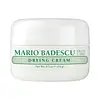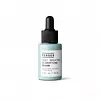What's inside
What's inside
 Key Ingredients
Key Ingredients

 Benefits
Benefits

 Concerns
Concerns

 Ingredients Side-by-side
Ingredients Side-by-side

Water
Skin ConditioningZinc Oxide
Cosmetic ColorantCetyl Alcohol
EmollientAloe Barbadensis Leaf Juice
Skin ConditioningCera Alba
EmollientPolysorbate 80
EmulsifyingGlycerin
HumectantEthylhexyl Palmitate
EmollientPropylene Glycol
HumectantSulfur
AntiseborrhoeicOleth-10
EmulsifyingParaffinum Liquidum
EmollientIchthammol
AntimicrobialHydrolyzed Yeast Protein
Skin ConditioningTriticum Vulgare Starch
AbrasiveArctium Lappa Root Extract
Skin ConditioningCysteine
AntioxidantNiacinamide
SmoothingPanthenol
Skin ConditioningNasturtium Officinale Flower/Leaf Extract
AntiseborrhoeicCitrus Limon Fruit Extract
MaskingAllantoin
Skin ConditioningBiotin
AntiseborrhoeicArginine
MaskingLeucine
Skin ConditioningLysine
Skin ConditioningTyrosine
MaskingValine
MaskingGlutamic Acid
HumectantCellulose Gum
Emulsion StabilisingPolysorbate 20
EmulsifyingMaltodextrin
AbsorbentZinc Chloride
AntimicrobialGlyceryl Acrylate/Acrylic Acid Copolymer
HumectantPyridoxine Hcl
Skin ConditioningParfum
MaskingSodium Chloride
MaskingMethylparaben
PreservativePropylparaben
PreservativePotassium Sorbate
PreservativeCitric Acid
BufferingSodium Benzoate
MaskingChlorphenesin
AntimicrobialDisodium EDTA
Phenoxyethanol
PreservativeBenzyl Benzoate
AntimicrobialAlpha-Isomethyl Ionone
PerfumingLimonene
PerfumingLinalool
PerfumingCI 77891
Cosmetic ColorantWater, Zinc Oxide, Cetyl Alcohol, Aloe Barbadensis Leaf Juice, Cera Alba, Polysorbate 80, Glycerin, Ethylhexyl Palmitate, Propylene Glycol, Sulfur, Oleth-10, Paraffinum Liquidum, Ichthammol, Hydrolyzed Yeast Protein, Triticum Vulgare Starch, Arctium Lappa Root Extract, Cysteine, Niacinamide, Panthenol, Nasturtium Officinale Flower/Leaf Extract, Citrus Limon Fruit Extract, Allantoin, Biotin, Arginine, Leucine, Lysine, Tyrosine, Valine, Glutamic Acid, Cellulose Gum, Polysorbate 20, Maltodextrin, Zinc Chloride, Glyceryl Acrylate/Acrylic Acid Copolymer, Pyridoxine Hcl, Parfum, Sodium Chloride, Methylparaben, Propylparaben, Potassium Sorbate, Citric Acid, Sodium Benzoate, Chlorphenesin, Disodium EDTA, Phenoxyethanol, Benzyl Benzoate, Alpha-Isomethyl Ionone, Limonene, Linalool, CI 77891
Water
Skin ConditioningGlycerin
HumectantNiacinamide
SmoothingSalix Nigra Bark Extract
Skin ProtectingZinc Gluconate
Skin ConditioningSodium Hyaluronate
HumectantSalicylic Acid
MaskingAesculus Hippocastanum Seed Extract
Skin ConditioningCeramide AP
Skin Conditioning1,2-Hexanediol
Skin ConditioningButylene Glycol
HumectantPhenoxyethanol
PreservativePEG-40 Hydrogenated Castor Oil
EmulsifyingHydroxyethylcellulose
Emulsion StabilisingYeast Extract
Skin ConditioningGlyceryl Acrylate/Acrylic Acid Copolymer
HumectantTrisodium Ethylenediamine Disuccinate
Ammonium Glycyrrhizate
MaskingBiotin
AntiseborrhoeicPanthenol
Skin ConditioningPropylene Glycol
HumectantCaffeine
Skin ConditioningWater, Glycerin, Niacinamide, Salix Nigra Bark Extract, Zinc Gluconate, Sodium Hyaluronate, Salicylic Acid, Aesculus Hippocastanum Seed Extract, Ceramide AP, 1,2-Hexanediol, Butylene Glycol, Phenoxyethanol, PEG-40 Hydrogenated Castor Oil, Hydroxyethylcellulose, Yeast Extract, Glyceryl Acrylate/Acrylic Acid Copolymer, Trisodium Ethylenediamine Disuccinate, Ammonium Glycyrrhizate, Biotin, Panthenol, Propylene Glycol, Caffeine
 Reviews
Reviews

Ingredients Explained
These ingredients are found in both products.
Ingredients higher up in an ingredient list are typically present in a larger amount.
Biotin is a B vitamin that is naturally produced by our bodies. It is also called Vitamin H.
Our bodies use biotin in the metabolism process. It also helps our bodies use enzymes and move nutrients around. A biotin deficiency can lead to brittle hair and nails.
More research is needed on applying biotin topically. However, taking biotin orally has been shown to help nourish the skin, hair, and nails. They play a role in forming skin-hydrating fatty acids.
Biotin is water-soluble. It can be found in foods such as fish, eggs, dairy, nuts, and meat. Vitamin H stands for "haar" and "haut". These are the German words for hair and skin.
Learn more about BiotinGlycerin is already naturally found in your skin. It helps moisturize and protect your skin.
A study from 2016 found glycerin to be more effective as a humectant than AHAs and hyaluronic acid.
As a humectant, it helps the skin stay hydrated by pulling moisture to your skin. The low molecular weight of glycerin allows it to pull moisture into the deeper layers of your skin.
Hydrated skin improves your skin barrier; Your skin barrier helps protect against irritants and bacteria.
Glycerin has also been found to have antimicrobial and antiviral properties. Due to these properties, glycerin is often used in wound and burn treatments.
In cosmetics, glycerin is usually derived from plants such as soybean or palm. However, it can also be sourced from animals, such as tallow or animal fat.
This ingredient is organic, colorless, odorless, and non-toxic.
Glycerin is the name for this ingredient in American English. British English uses Glycerol/Glycerine.
Learn more about GlycerinGlyceryl Acrylate/Acrylic Acid Copolymer is made up of glycerin and polyacrylic acid. It helps hydrate your skin as a humectant.
This ingredient forms a hydrogel that delivers moisturizing, water-based ingredients to the skin. It is also used to thicken a product and to give it a smooth texture.
Acrylic acid itself is toxic, but the polymer form (this ingredient) is too large to penetrate skin, making it non-toxic.
Learn more about Glyceryl Acrylate/Acrylic Acid CopolymerNiacinamide is a multitasking form of vitamin B3 that strengthens the skin barrier, reduces pores and dark spots, regulates oil, and improves signs of aging.
And the best part? It's gentle and well-tolerated by most skin types, including sensitive and reactive skin.
You might have heard of "niacin flush", or the reddening of skin that causes itchiness. Niacinamide has not been found to cause this.
In very rare cases, some individuals may not be able to tolerate niacinamide at all or experience an allergic reaction to it.
If you are experiencing flaking, irritation, and dryness with this ingredient, be sure to double check all your products as this ingredient can be found in all categories of skincare.
When incorporating niacinamide into your routine, look out for concentration amounts. Typically, 5% niacinamide provides benefits such as fading dark spots. However, if you have sensitive skin, it is better to begin with a smaller concentration.
When you apply niacinamide to your skin, your body converts it into nicotinamide adenine dinucleotide (NAD). NAD is an essential coenzyme that is already found in your cells as "fuel" and powers countless biological processes.
In your skin, NAD helps repair cell damage, produce new healthy cells, support collagen production, strengthen the skin barrier, and fight environmental stressors (like UV and pollution).
Our natural NAD levels start to decline with age, leading to slower skin repair, visible aging, and a weaker skin barrier. By providing your skin niacinamide, you're recharging your skin's NAD levels. This leads to stronger, healthier, and younger looking skin.
Another name for vitamin B3 is nicotinamide. This vitamin is water-soluble and our bodies don't store it. We obtain Vitamin B3 from either food or skincare. Meat, fish, wheat, yeast, and leafy greens contain vitamin B3.
The type of niacinamide used in skincare is synthetically created.
Learn more about NiacinamidePanthenol is a common ingredient that helps hydrate and soothe the skin. It is found naturally in our skin and hair.
There are two forms of panthenol: D and L.
D-panthenol is also known as dexpanthenol. Most cosmetics use dexpanthenol or a mixture of D and L-panthenol.
Panthenol is famous due to its ability to go deeper into the skin's layers. Using this ingredient has numerous pros (and no cons):
Like hyaluronic acid, panthenol is a humectant. Humectants are able to bind and hold large amounts of water to keep skin hydrated.
This ingredient works well for wound healing. It works by increasing tissue in the wound and helps close open wounds.
Once oxidized, panthenol converts to pantothenic acid. Panthothenic acid is found in all living cells.
This ingredient is also referred to as pro-vitamin B5.
Learn more about PanthenolPhenoxyethanol is a preservative that has germicide, antimicrobial, and aromatic properties. Studies show that phenoxyethanol can prevent microbial growth. By itself, it has a scent that is similar to that of a rose.
It's often used in formulations along with Caprylyl Glycol to preserve the shelf life of products.
Propylene Glycol is an odorless, colorless liquid. As a humectant, it helps skin retain moisture. It also aids in delivering active ingredients.
Another role of this ingredient is preventing a product from melting or freezing. Propylene glycol also adds antimicrobrial properties to a product, elongating product lifespan.
This ingredient is considered an organic alcohol and commonly added into both cosmetics and foods.
Those with sensitive skin or conditions may develop a rash when using this ingredient.
Learn more about Propylene GlycolWater. It's the most common cosmetic ingredient of all. You'll usually see it at the top of ingredient lists, meaning that it makes up the largest part of the product.
So why is it so popular? Water most often acts as a solvent - this means that it helps dissolve other ingredients into the formulation.
You'll also recognize water as that liquid we all need to stay alive. If you see this, drink a glass of water. Stay hydrated!
Learn more about Water